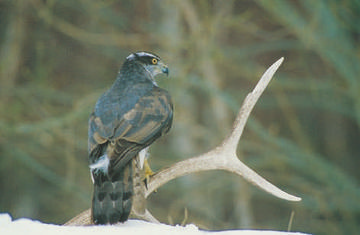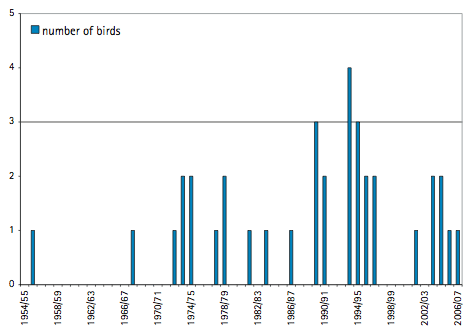
Goshawk © Peter Smith
‘Goshawks are rarely seen in Britain and Ireland, even in those areas where there are established populations’: so began the text for the BTO Winter Atlas. Thus, it is no surprise that there are few records on the winter Atlas map of Cheshire and Wirral. In only four tetrads were observers able to provide a description that satisfied the county rarities panel, the four birds being an adult and immature of the two sexes. None of these tetrads had a breeding season record, despite this species’ sedentary nature and early display, perhaps another measure of their secretive nature. The extent of under-recording can be quantified from the tetrad atlases of Northumbria, where there were at least 50 pairs breeding producing more than 100 young a year. So, fieldworkers are well used to seeing Goshawks, but only 70 birds were recorded in the three seasons (1996/ 97 to 1998/ 99) of the county’s wintering atlas (Day & Hodgson 2003).
However, despite the difficulty in recording the species, Goshawks are unlikely to be common or widespread in Cheshire and Wirral because they need substantial areas of woodland. In winter this requirement is relaxed somewhat and birds spend more time hunting in open areas. The observers of these four records provided seven habitat codes, all different: broadleaved and coniferous woodland; scrub – ‘regenerating natural or semi-natural woodland’; dry semi-natural grassland, unimproved agricultural grassland and mixed grassland/ tilled land; and dry heath. These indicate the wide range of area over which Goshawks can be found.

Goshawk wintering numbers.
Wherever they are, Goshawks should have no difficulty in finding food in a Cheshire winter. As well as large birds – of the size of Woodpigeons, Moorhens, corvids and the like – they also prey on the larger thrushes, especially Fieldfares, and regularly eat medium-sized mammals, mainly squirrels and rabbits.
The ornithological history of Goshawk in Cheshire and Wirral appears straightforward but for the last quarter-century is clouded by rumour, doubts over identification and caution on publishing records. Coward and Oldham, and Boyd, make no mention of the species. Bell’s only reference is to one seen on Christmas Day in 1955, which was such an unusual record that it was published in British Birds. The annual county bird reports contain few records from the winter period, excluding the occasional cryptic references to ‘well-known resident pairs’ and birds known to be escaped captive birds. The plot shows a mean of only one per winter, and a maximum of four birds in any of the thirty years before this winter atlas; thus, the four birds recorded in three winters of this project is about average.
Sponsored by Syngenta CTL

